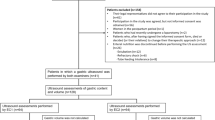Abstract
Background
Ultrasound is the modality of choice for the diagnosis of hypertrophic pyloric stenosis (HPS). The evolution of high-frequency transducers in ultrasound has led to inconsistent ways of measuring the pylorus.
Objective
To standardize the measurements and evaluate the appearance of the normal and hypertrophied pylorus with high-frequency transducers.
Materials and methods
We retrospectively analyzed abdominal ultrasounds of infants with suspected HPS from January 2019-December 2020. We classified the layers of the pylorus while assessing the stratified appearance. Two pediatric radiologists measured the muscle thickness of the pylorus independently by two methods for interrater agreement. Measurement (a) includes the muscularis propria and muscularis mucosa. Measurement (b) includes only the muscularis propria. We also evaluated the echogenicity of the muscularis propria. The interrater agreement, mean, range of the muscle thickness, and the diagnostic accuracy of the two sets of measurements were calculated.
Results
We included 300 infants (114 F:186 M), 59 with HPS and 241 normal cases. There was a strong agreement between the readers assessed in the first 100 cases, and ICC was 0.99 (95% CI, 0.98–0.99). Measurement (a), median thickness is 2.4 mm in normal cases and 4.8 mm in HPS. Measurement (b), median thickness is 1.4 mm in normal cases and 4.0 mm in HPS. Measurement (a) has an accuracy of 89.7% (95% CI, 85.7−92.8%) with 98.3% sensitivity and 87.6% specificity. Measurement (b) has an accuracy of 98.0% (95% CI, 95.7−99.3%) with 89.8% sensitivity and 100.0% specificity. The pylorus stratification is preserved in all normal cases and 31/59 (52.5%) cases of HPS. There was complete/partial loss of stratification in 28/59 (47.5%) cases of HPS. In all HPS cases, the muscularis propria was echogenic.
Conclusion
Measuring the muscularis propria solely has a better diagnostic accuracy, decreasing the overlap of negative and positive cases. The loss of pyloric wall stratification and echogenic muscularis propria is only seen in HPS.
Graphical abstract





Similar content being viewed by others
Data availability
The data used in this study is available upon reasonable request from the corresponding author.
References
Hernanz-Schulman M (2009) Pyloric stenosis: role of imaging. Pediatr Radiol 39:134–139
Rohrschneider WK, Mittnacht H, Darge K, Tröger J (1998) Pyloric muscle in asymptomatic infants: sonographic evaluation and discrimination from idiopathic hypertrophic pyloric stenosis. Pediatr Radiol 28:429–434
Stunden RJ, LeQuesne GW, Little KE (1986) The improved ultrasound diagnosis of hypertrophic pyloric stenosis. Pediatr Radiol 16:200–205
Teele RL, Smith EH (1977) Ultrasound in the diagnosis of idiopathic hypertrophic pyloric stenosis. N Engl J Med 296:1149–1150
Blumhagen JD, Coombs JB (1981) Ultrasound in the diagnosis of hypertrophic pyloric stenosis. J Clin Ultrasound 9:289–292
Blumhagen JD, Maclin L, Krauter D et al (1988) Sonographic diagnosis of hypertrophic pyloric stenosis. Am J Roentgenol 150:1367–1370
(1991) Antropyloric muscle thickness at us in infants: What is normal? J Diagn Med Sonography 7:235–236. https://doi.org/10.1177/875647939100700421
Hernanz-Schulman M, Sells LL, Ambrosino MM et al (1994) Hypertrophic pyloric stenosis in the infant without a palpable olive: accuracy of sonographic diagnosis. Radiology 193:771–776
Calle-Toro JS, Kaplan SL, Andronikou S (2019) Are we performing ultrasound measurements of the wall thickness in hypertrophic pyloric stenosis studies the same way? Pediatr Surg Int 36:399–405
Godbole P, Sprigg A, Dickson JA, Lin PC (1996) Ultrasound compared with clinical examination in infantile hypertrophic pyloric stenosis. Arch Dis Child 75:335–337
Costa Dias S, Swinson S, Torrão H et al (2012) Hypertrophic pyloric stenosis: tips and tricks for ultrasound diagnosis. Insights into Imaging 3:247–250
Cohen HL, Zinn HL, Haller JO et al (1998) Ultrasonography of pylorospasm: findings may simulate hypertrophic pyloric stenosis. J Ultrasound Med 17:705–711
Hernanz-Schulman M (2003) Infantile hypertrophic pyloric stenosis. Radiology 227:319–331
Author information
Authors and Affiliations
Corresponding author
Ethics declarations
Conflicts of interest
None
Additional information
Publisher’s Note
Springer Nature remains neutral with regard to jurisdictional claims in published maps and institutional affiliations.
Rights and permissions
Springer Nature or its licensor (e.g. a society or other partner) holds exclusive rights to this article under a publishing agreement with the author(s) or other rightsholder(s); author self-archiving of the accepted manuscript version of this article is solely governed by the terms of such publishing agreement and applicable law.
About this article
Cite this article
Yousef, A., Daneman, A., Amirabadi, A. et al. The impact of high-frequency transducers on the sonographic measurements of the pyloric muscle thickness in infants. Pediatr Radiol 54, 737–742 (2024). https://doi.org/10.1007/s00247-024-05881-0
Received:
Revised:
Accepted:
Published:
Issue Date:
DOI: https://doi.org/10.1007/s00247-024-05881-0




